Welcome to our article on Echinodorus Horemanii Red, a stunning aquatic plant that can bring a vibrant touch to your aquarium. With its beautiful red color and unique leaf structure, this plant will surely catch the eye of any aquarium enthusiast.
In this article, we will explore the characteristics of Echinodorus Horemanii Red and provide valuable tips on caring for and maintaining its vibrant beauty in your aquarium.
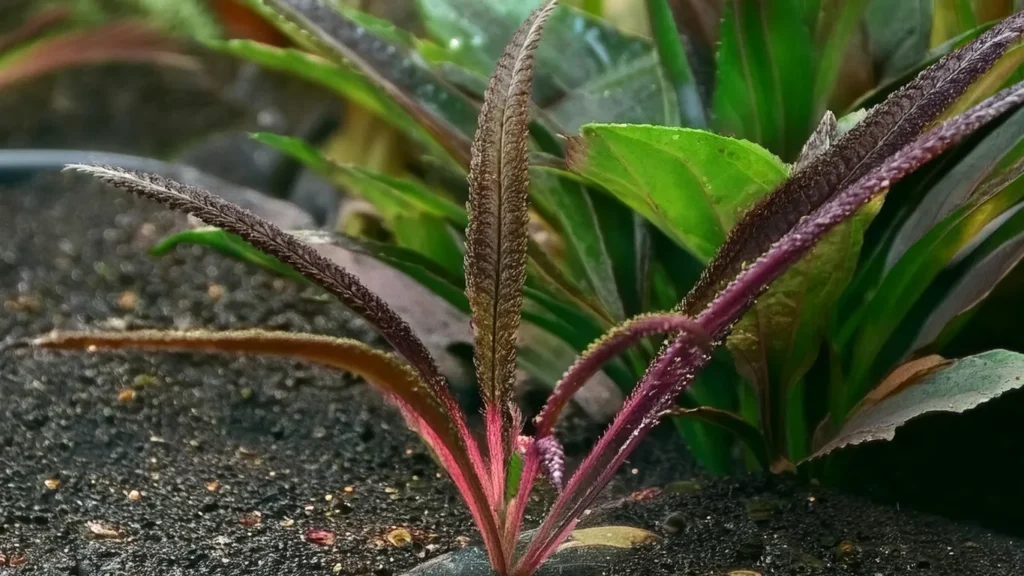
Key Takeaway
- Echinodorus Horemanii Red is an eye-catching aquatic plant with a vibrant red color and unique leaf structure.
- This plant is suitable for beginner and experienced aquarium hobbyists due to its easy care.
- Proper lighting, water quality, and nutrient balance are essential for maintaining the health and vitality of Echinodorus Horemanii Red.
- Strategically placing this plant in your aquarium can create visually stunning aquascapes.
- Propagation, pruning, and pest management are important aspects of caring for Echinodorus Horemanii Red.
Quick Stats
| Attribute | Details |
| Family Name | Alismataceae |
| Origin | Cultivar |
| Height | 20-50 cm (8-20 inches) |
| pH Range | 6.0 – 7.5 |
| CO2 Requirement | Moderate |
| Growth Rate | Moderate |
| Care Level | Moderate |
| Color Form | Green to Red, depending on lighting and nutrient conditions |
| Water Conditions | 22-28°C (72-82°F), soft to moderately hard water |
| Max Size | Leaves can reach 50 cm (20 inches) in length |
| Lighting | High, to encourage red coloration |
| Supplements | Iron-rich fertilizers, CO2 supplementation |
| Placement | Mid-ground to Background |
| Propagation | By adventitious shoots from the base or seeds |
What Is Echinodorus Horemanii Red?
Echinodorus Horemanii Red, also known as Red Amazon Sword, is a captivating aquatic plant that belongs to the Echinodorus genus. Native to South America, this species is highly valued for its vibrant red coloration, which adds a stunning visual element to any aquarium.
Here at [Brand Name], we understand the appeal of Echinodorus Horemanii Red and aim to provide comprehensive information to help you maintain the health and beauty of this beautiful plant.
Natural Habitat And Origin
- Echinodorus horemanii “Red,” also known as the Red Amazon Sword, is a popular aquatic plant cultivated for aquariums. Understanding its natural habitat and origin can provide insight into its care requirements. However, it’s important to note that the specific origins of cultivated varieties, such as the “Red” variant of Echinodorus horemanii, may not always be well-documented or easily traceable.
- Generally, Echinodorus horemanii originates from regions in South America, particularly Brazil and neighboring countries. These plants typically grow in freshwater habitats such as rivers, streams, ponds, and marshes, where they thrive in submerged or semi-submerged conditions.
- The “Red” variant of Echinodorus horemanii likely developed through selective breeding or natural variation to exhibit distinctive red or reddish-brown coloration in its leaves. This coloration is often more intense under high light conditions and may vary depending on factors such as water chemistry, nutrient availability, and lighting.
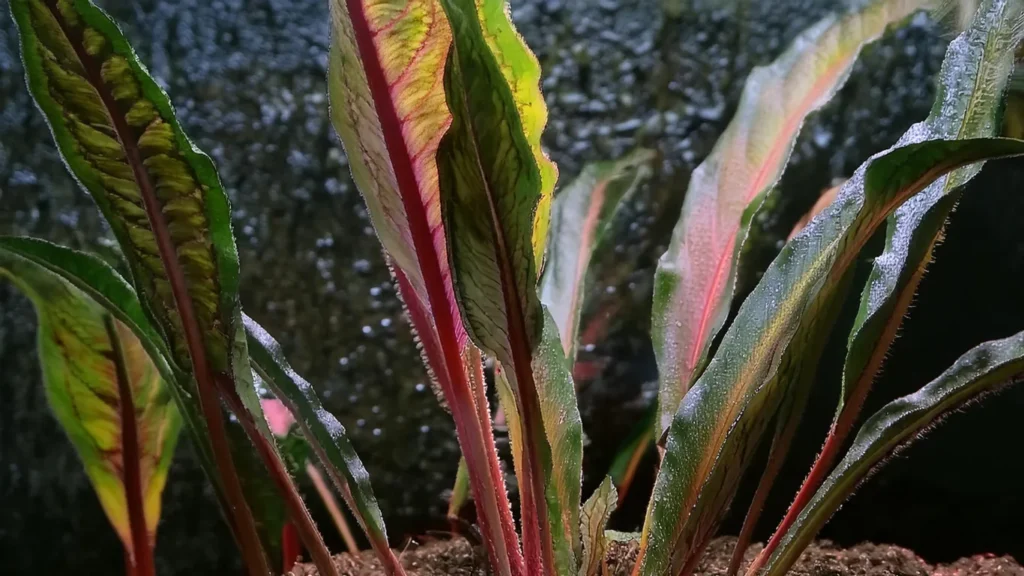
Characteristics Of Echinodorus Horemanii Red
- Echinodorus Horemanii Red is an exquisite aquatic plant known for its deep red coloration and long, lance-shaped leaves. This vibrant plant can reach a height of about 12-18 inches, adding a stunning focal point to any aquarium. Its striking appearance makes it a popular choice among both beginner and experienced aquarium hobbyists.
- One of the key factors in maintaining the vibrant color of Echinodorus Horemanii Red is providing moderate to high lighting levels. This ensures that the plant retains its eye-catching red hue, enhancing the visual appeal of your planted tank.
- This species is relatively easy to care for and can thrive in a wide range of water conditions, making it a versatile choice for tropical aquariums. It is adaptable and can withstand varying pH levels, water hardness, and temperatures, providing flexibility for aquarists.
Effect Of Lighting, Filters, And CO2 Systems On Plant Growth
- Lighting is a key factor in the successful cultivation of Echinodorus Horemanii Red. Sufficient light intensity is necessary to support photosynthesis and maintain the plant’s vibrant red color. Based on the plant’s requirements, it is important to provide the appropriate lighting duration and intensity.
- Filters play a crucial role in maintaining water quality by removing debris and impurities. They help to maintain a stable and clean environment, promoting healthy plant growth. Regular filter maintenance is necessary to ensure optimal performance.
- CO2 systems can greatly enhance the growth of Echinodorus Horemanii Red in a planted tank. Carbon dioxide supplementation promotes efficient photosynthesis, leading to faster growth and improved coloration. The use of CO2 systems should be balanced and monitored to prevent fluctuations in CO2 levels that could harm the plants or aquatic life.
Temperature Parameters
- Temperature Range: Aim to keep the water temperature within the range of 72°F to 82°F (22°C to 28°C) for Echinodorus horemanii “Red.”
- Tropical Conditions: Echinodorus plants are native to tropical regions of South America, where they thrive in warm water environments. Mimicking these tropical conditions in your aquarium helps promote optimal growth and overall health.
- Stability: Maintain stable water temperatures within the recommended range to prevent temperature fluctuations, which can stress the plants and compromise their growth.
- Heaters: Use aquarium heaters to regulate water temperature and ensure it remains within the preferred range. Choose a heater appropriate for the size of your aquarium and monitor temperature regularly to prevent deviations.
- Seasonal Adjustments: Consider seasonal adjustments to your aquarium temperature if necessary. For example, during colder months, you may need to increase the heater’s setting slightly to maintain optimal temperatures.
- Compatibility: Ensure that the temperature preferences of Echinodorus horemanii “Red” align with those of other aquarium inhabitants. Choose tank mates that also prefer similar tropical temperatures to promote overall compatibility and well-being.

Importance Of Water Quality And Nutrients
- Water quality is critical in maintaining a healthy aquarium environment for Echinodorus Horemanii Red.
- Monitoring and maintaining appropriate parameters such as pH, temperature, and water hardness is essential. These factors directly impact the plant’s ability to absorb nutrients and thrive.
- An adequate supply of nutrients is crucial for the growth and development of Echinodorus Horemanii Red.
- Liquid fertilizers or root tabs can be used to provide essential nutrients such as nitrogen, phosphorus, and potassium. These nutrients support the plant’s vibrant coloration and overall health.
Substrate Requirements
- Nutrient-Rich Substrate: Echinodorus horemanii “Red” benefits from a nutrient-rich substrate that provides essential nutrients for healthy growth. Choose substrates specifically formulated for planted aquariums, such as aquasoil, nutrient-rich gravel, or clay-based substrates. These substrates typically contain a blend of macro and micronutrients that support plant growth.
- Depth: The substrate depth should be sufficient to anchor the plant securely and provide space for root development. Aim for a substrate depth of at least 2 to 3 inches (5 to 7.5 centimeters) to ensure adequate coverage and stability.
- Granule Size: Select a substrate with an appropriate granule size that allows for proper root penetration and prevents compaction. Fine-grained substrates may compact over time, restricting root growth, while coarse substrates may allow for better water circulation and root development.
- Fertilization: While a nutrient-rich substrate provides a solid foundation for plant growth, additional fertilization may be necessary, especially in heavily planted aquariums or if the substrate nutrients become depleted over time. Supplement with root tabs or liquid fertilizers as needed to ensure continuous nutrient availability.
Placement Option In Tank
- The placement of Echinodorus Horemanii Red in your planted tank can greatly impact the overall aesthetics of the aquarium. This species is suitable for both mid-ground and background positions due to its height and vibrant coloration.
- It can be used as a focal point or combined with other mid-ground and background plants to create a visually stunning aquascape.
- When considering the placement of Echinodorus Horemanii Red, think about the size and shape of your tank. If you have a larger tank, you can use this plant as a background plant to create a lush and vibrant backdrop. In smaller tanks, it works well as a mid-ground plant, bringing depth and visual interest to the aquarium.
- One way to enhance the visual appeal of your planted tank is by combining Echinodorus Horemanii Red with other compatible mid-ground and background plants.
- This creates a natural and balanced look, adding texture and variety to the aquascape. Some popular choices for accompanying plants include Anubias, Amazon Sword, Cryptocoryne, and Ludwigia.
- These plants complement the vibrant red color of Echinodorus Horemanii Red and create a harmonious display.

Recommended Tank Size
- For Small Groups or Individuals: If you plan to keep a small group or a few individual specimens of Echinodorus horemanii “Red,” a tank size of at least 10 gallons (approximately 38 liters) can be suitable. This size provides enough space for the plants to spread and grow without overcrowding.
- For Dense Plantings: If you aim to create a dense planting of Echinodorus horemanii “Red” or include a larger number of plants, consider a larger tank. A tank size of 20 gallons (approximately 75 liters) or more would provide ample space for a lush display of these plants.
- Consider Overall Layout: When selecting a tank size, consider the overall layout and design of your aquarium. Ensure that there is sufficient space in the foreground, mid-ground, or background of the tank for planting Echinodorus horemanii “Red” according to your desired aquascape design.
- Compatibility: Take into account the needs of other inhabitants of the aquarium, such as fish and invertebrates. Choose a tank size that accommodates the requirements of all species and provides enough swimming and hiding space.
RELATED: Dwarf Chain Sword For A Lush Carpet In Your Aquascape
Suitable Mates For Echinodorus Horemanii Red
Peaceful Community Fish: Many peaceful community fish make excellent tank mates for Echinodorus horemanii “Red.” Examples include:
- Tetras (such as neon tetras, cardinal tetras)
- Rasboras
- Guppies
- Mollies
- Platies
- Dwarf Gouramis
Bottom Dwellers: Species that inhabit the lower levels of the aquarium can coexist well with Echinodorus horemanii “Red.” Consider adding:
- Corydoras catfish
- Dwarf corydoras
- Kuhli loaches
Shrimp and Snails: Many species of freshwater shrimp and snails make great tank mates for Echinodorus horemanii “Red” and help clean up debris. Consider:
- Cherry shrimp
- Amano shrimp
- Nerite snails
- Malaysian trumpet snails
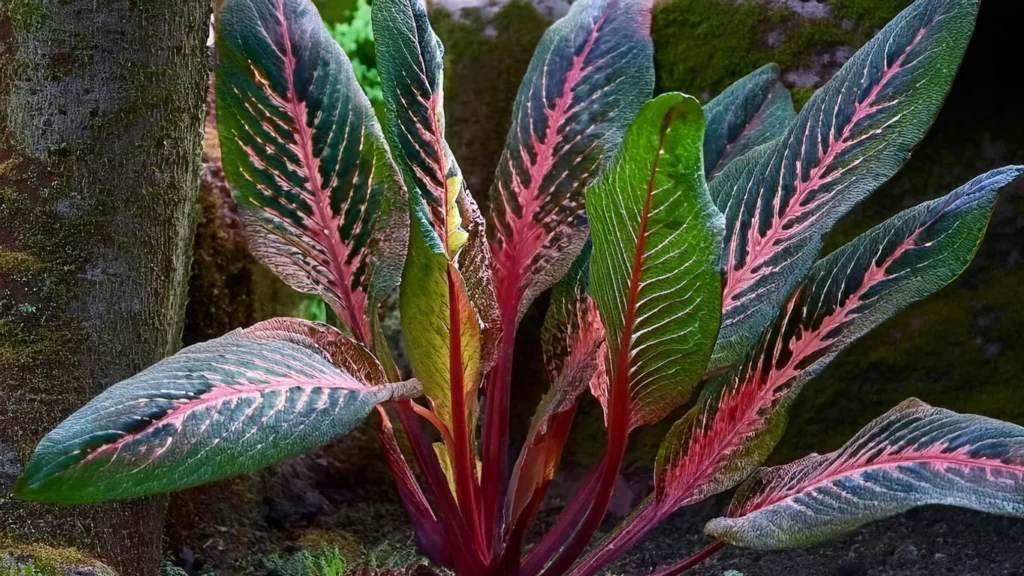
Nutritional Needs
Meeting the nutritional needs of Echinodorus horemanii “Red” is crucial for its growth, coloration, and overall health. Like all aquatic plants, it requires a balance of macronutrients and micronutrients for optimal development. Here’s an overview of its nutritional requirements:
Macronutrients
- Nitrogen (N): Essential for chlorophyll synthesis, which is crucial for photosynthesis and overall plant growth.
- Phosphorus (P): Important for energy transfer, root development, and flower production.
- Potassium (K): Facilitates enzyme activation, osmoregulation, and overall plant vigor.
Micronutrients
- Iron (Fe): Necessary for chlorophyll production and enzymatic processes.
- Magnesium (Mg): Component of chlorophyll molecules, essential for photosynthesis.
- Calcium (Ca): Important for cell wall structure and overall plant integrity.
- Other micronutrients: Including but not limited to zinc (Zn), copper (Cu), manganese (Mn), boron (B), and molybdenum (Mo), which are required in trace amounts for various physiological processes.
Echinodorus Horemanii Red Cultivation Tips
- Lighting: Provide moderate to high lighting levels for Echinodorus horemanii “Red” to support photosynthesis and encourage vibrant red coloration. Full-spectrum LED or fluorescent lights with a color temperature around 6500K are ideal for promoting healthy growth and coloration.
- Substrate: Use a nutrient-rich substrate specifically designed for planted aquariums. Ensure the substrate is deep enough to anchor the plant securely and provide ample space for root development. Consider using root tabs or nutrient supplements to provide additional nutrients directly to the plant’s roots.
- CO2 Injection: Consider supplementing your aquarium with CO2 injection to enhance plant growth and coloration, especially in high-tech planted tanks. CO2 supplementation can promote lush growth and intensify the red coloration of Echinodorus horemanii “Red.”
- Fertilization: Provide regular fertilization to ensure the plant receives all essential nutrients for healthy growth. Choose a comprehensive liquid fertilizer formulated for aquarium plants and follow the dosage instructions carefully to prevent nutrient deficiencies or imbalances.
Plant Propagation Tips
- Rhizome Division: Divide the rhizome into sections with healthy roots and leaves, then plant them separately.
- Separation of Plantlets: Wait for plantlets to develop roots and leaves, then carefully separate them from the parent plant and replant.
- Leaf Cuttings: Select healthy leaves and cut them into sections, then plant them in the substrate to encourage new growth.
- Provide Optimal Conditions: Ensure the propagated plants have adequate lighting, nutrient-rich substrate, and stable water parameters.
- Be Patient: Propagation may take time, so monitor the growth and provide regular care as needed.
- Trim and Maintain: After propagation, trim any damaged leaves and maintain proper care to ensure healthy growth.
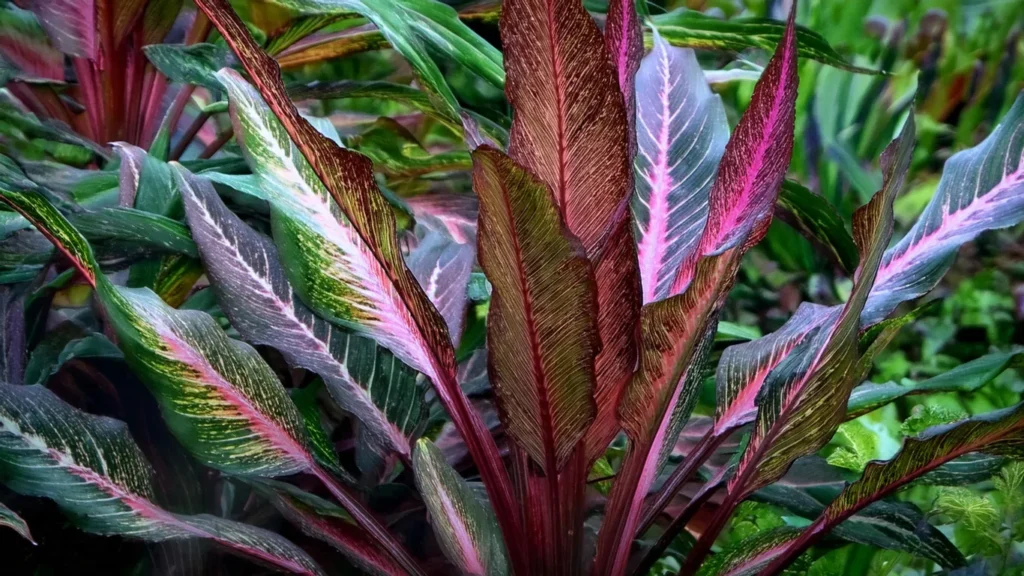
Benefits Of Planting Echinodorus Horemanii Red
- Visual Appeal: Echinodorus horemanii “Red” adds vibrant red foliage to your aquarium, creating a striking focal point and enhancing the overall aesthetic appeal of your aquascape.
- Natural Habitat Simulation: The dense foliage of Echinodorus horemanii “Red” replicates the natural habitat of aquatic plants in rivers, streams, and marshes, providing a more natural and visually pleasing environment for your aquarium inhabitants.
- Oxygenation: Like all aquatic plants, Echinodorus horemanii “Red” contributes to oxygenation by releasing oxygen during photosynthesis. This helps maintain healthy oxygen levels for fish and other aquatic organisms in the tank.
- Water Filtration: The root system of Echinodorus horemanii “Red” helps absorb excess nutrients from the water column, reducing the risk of algae overgrowth and improving water quality in the aquarium.
Habitat and Shelter: The dense foliage of Echinodorus horemanii “Red” provides shelter and hiding places for fish, shrimp, and other aquatic inhabitants, reducing stress and promoting natural behaviors.
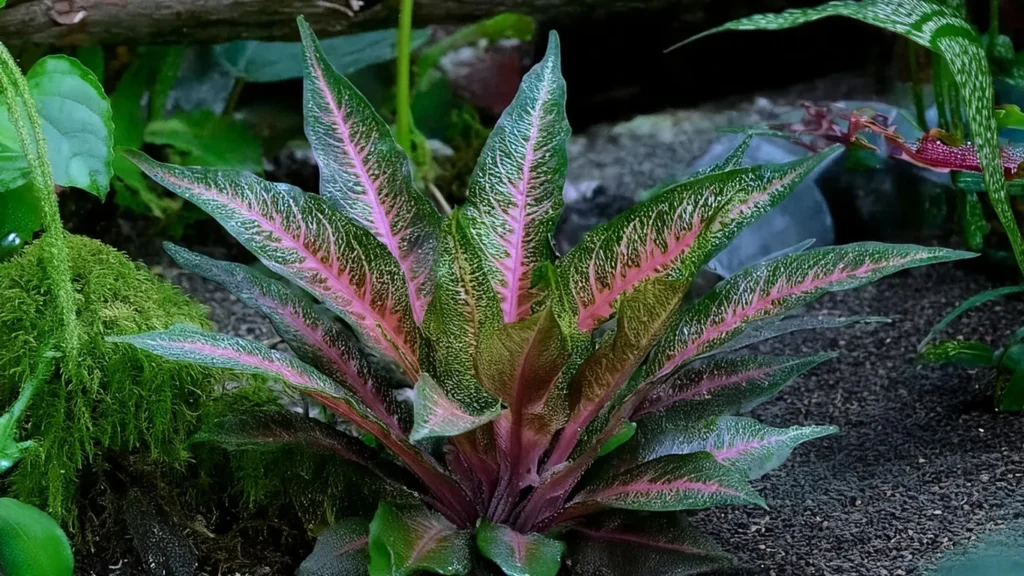
Common Challenges In Maintaining Aquatic Plant Health
- Aquatic plant health can be affected by various challenges, including algae growth, nutrient deficiencies, and disease outbreaks. Algae growth is a common issue in aquariums and can be controlled by maintaining proper nutrient balance, ensuring adequate water flow, and implementing a regular cleaning routine.
- Nutrient deficiencies can manifest as yellowing or stunted growth in aquatic plants. Monitor the condition of your Echinodorus Horemanii Red and provide appropriate fertilization to address any nutrient deficiencies. Regular pruning of damaged or unhealthy leaves can also help promote new growth.
- Disease outbreaks, such as fungal or bacterial infections, can occur in aquatic plants. To prevent disease, maintain proper water quality, avoid overcrowding, and quarantine new plants before introducing them into your aquarium. If you suspect a disease outbreak, promptly address it with appropriate treatments to protect the health of your Echinodorus Horemanii Red and other aquatic plants.
Conclusion
It is a vibrant and eye-catching aquatic plant that can enhance the beauty of any aquarium. Its unique characteristics and ability to adapt to different aquatic environments make it popular among plant enthusiasts.
By following proper care and maintenance techniques, including providing the ideal environment, propagating and pruning as needed, and addressing potential pests, you can ensure the health and longevity of your Echinodorus Horemanii Red plants.
With its striking red coloration, this plant is sure to be a focal point in your planted tank.
Frequently Asked Question
What Specific Light Spectrum And Intensity Are Needed To Maximize The Red Pigmentation In Echinodorus ‘horemanii Red’?
To maximize the red pigmentation of it provides high-intensity lighting with a spectrum that includes more red and blue wavelengths.
Lighting systems that offer full-spectrum LEDs or specific settings for enhancing red colors are ideal. Aim for a PAR (Photosynthetically Active Radiation) value above 50 at the substrate level.
The high light intensity promotes growth and enhances the red pigmentation through increased anthocyanin production in the leaves.
How Does Co2 Supplementation Affect The Growth And Coloration Of Echinodorus ‘horemanii Red’?
CO2 supplementation significantly impacts the growth rate and coloration of Echinodorus ‘Horemanii Red.’ Adding CO2 to the aquarium water can enhance photosynthesis efficiency, leading to vigorous growth and deeper, more vibrant red hues in the leaves.
Aim for a CO2 concentration of 20-30 ppm for optimal results, but fish and other aquatic life are monitored for signs of distress from CO2 levels.
What Are The Most Effective Fertilization Strategies For Maintaining The Health And Color Of Echinodorus ‘horemanii Red’?
An effective fertilization strategy for this includes substrate and water column supplementation. Use a nutrient-rich substrate or root tabs to provide essential nutrients directly to the roots.
A comprehensive liquid fertilizer that includes micronutrients, especially iron, should also be administered, crucial for promoting vibrant red colors. Monitor nutrient levels and plant response to adjust dosing as necessary, avoiding excesses that can lead to algae growth.
Can Echinodorus ‘horseman Red’ Be Propagated, And If So, What Method Works Best?
It can be propagated by separating daughter plants that emerge from the base of the parent plant. These daughter plants will develop their root systems while still attached to the parent.
Once they have a few leaves and a sufficient root system, they can be carefully cut away from the parent and planted individually in the substrate. This vegetative propagation method ensures that the offspring retain the desirable characteristics of the parent plant.
How Do I Address Common Issues Like Leaf Discoloration Or Melting In Echinodorus ‘horemanii Red’?
Leaf discoloration or melting in Echinodorus ‘Horemanii Red’ can result from several factors, including nutrient deficiencies, abrupt changes in water parameters, or inadequate lighting. Address nutrient deficiencies by adjusting your fertilization regimen, ensuring a balanced supply of macro and micronutrients.
Gradually acclimate the plant to new water conditions to prevent shock. If lighting is insufficient, consider upgrading to a higher intensity or adjusting the light spectrum to promote healthier growth. Removing affected leaves can also help the plant focus its energy on new, healthy growth.
- Unveiling The Wonders Of Riccia Fluitans In Aquascapes - August 7, 2024
- Vallisneria Gigantea Var. Guide To Care And Cultivation At Home - July 31, 2024
- Vesicularia Dubyana Care & Growth Guide Tips For Beginner Gardeners - July 30, 2024
